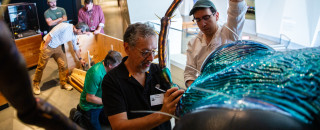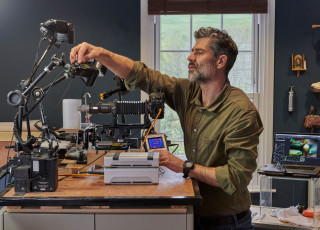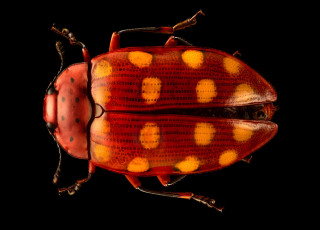Hollywood Delivers a Giant Tiger Beetle to Salt Lake City
Interested in bugs? Check out BUGfest, a weekend-long festival happening at NHMU on August 10–11!
By Mark Johnston
When examining a tiger beetle in the invertebrates collection at the Natural History Museum of Utah, a magnifying glass or microscope is needed to admire the tiny details and vibrant colors of an insect that grows merely a half inch long. However, for a tiger beetle specimen that arrived at the Museum in late July, no magnification is needed. Delivered in crates and pieced together outside the Microsculpture exhibition, this tiger beetle is a large model shows off the fierce predator's head at 300 times life size with picture-perfect, three-dimensional detail.
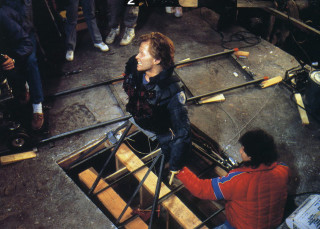
Fernando Favila works on the model of a human figure on the set of Robocop. Photo provided by Fernando Favila
The model was dreamed up by Fernando S. Favila, a makeup effects and specialty costume expert who has spent 42 years honing his craft on Hollywood productions. His many credits include Fear and Loathing in Las Vegas, Seven, Total Recall, Robocop, Mission Impossible, Batman Versus Superman, and the upcoming Tron: Ares. He has worked with many Hollywood greats, from director M. Night Shyamalan to the legendary star Jack Nicholson.
On each production, as one might expect from a life in Hollywood, Favila recalls fascinating stories, like the time he needed to make a life cast of Nicholson for the 1987 film Witches of Eastwick, but not before the actor sat Favila and his crew down to watch an entire Lakers versus Celtics basketball game on television.
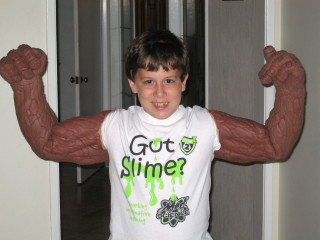
Fernando's son, Fernando F. Favila, wearing "THING" arms I brought home from the set of Fantastic Four: Rise of the Silver Surfer in 2005. Photo provided by Fernando Favila
Over the years, Favila’s work evolved from makeup effects in the 1980s and 1990s to specialty costumes as the superhero genre flourished in the 2000s. His craft employs sculpting, molding, casting, and digital design, and for the past eight years, Favila has applied his trade at Ironhead Studio in Van Nuys, California.
The team at Ironhead Studio stays busy producing costume and set pieces for the many superhero and sci-fi productions that dominate Hollywood these days (Transformers, X-Men, and Spiderman films just to name a few), as well as music videos for the likes of Kid Cudi and Daft Punk. However, from time to time the team can pursue a passion project, the latest of which was sparked by a conversation between Favila and his colleague and fabricator Jenn Rose.
Rose is an entomology enthusiast who has amassed a collection of invertebrates at home. Whenever the opportunity arose, she would tell Favila all about them and also encouraged him to attend the annual Bug Fair at the Natural History Museum of Los Angeles County (NHMLA), which he did. During that visit, Favila was amazed to see not only the vast number of invertebrate specimens on display, but also the great enthusiasm with which children approached microscopes and magnifying glasses to examine them.
The Bug Fair was hosted among NHMLA’s famous, towering dinosaur fossils that command the attention of guests on most visits. Looking around, Fernando thought:
“Wouldn’t it be grand to take these incredible invertebrate specimens and do a large-scale, photo-accurate model so that you could walk around it instead of trying to look through a microscope or magnifying lens.”
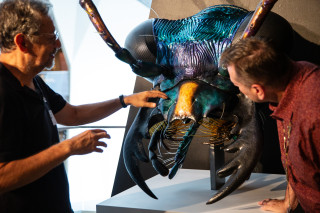
Fernando Favila Sr. shows Dr. Jason Cryan details on the large tiger beetle model. Photo by Mark Johnston
Thus started Favila’s journey into the world of entomology in 2017, and he soon received enthusiastic approval from the owner of Ironhead Studio, Jose Fernandez, to commence his passion project. But first much research—a few years in fact—was needed, both on what species to select and how to build the most picture-perfect model of a tiny insect.
At that time, Favila was aware of the work of Levon Biss, the photographer behind the famous Microsculpture exhibition and book that feature some of the most incredible invertebrate macrophotography ever produced. While Favila had not attended the exhibit, he did own a copy of the book which inspired his subject selection.
“The way Levon presents invertebrates in his book, they’re almost like jewelry, like gem pieces, and that’s exactly the way I wanted to do it,” Favila recalled. “After seeing the reaction to Levon’s amazing 2D work I thought let’s take it to 3D!”
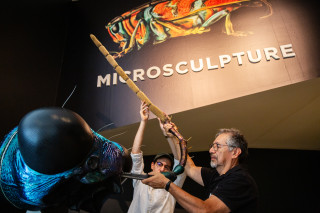
The two Fernandos install a towering antennae on the tiger beetle model outside the Microsculpture exhibition at NHMU. Photo by Mark Johnston
After searching far and wide for the best insect to be his subject, Favila teamed up with Dr. Rodger Gwiazdowski, a leading conservation biologist of invertebrates who helped him pick out Prothyma quadriguttata, a tiger beetle that had been collected in Indonesia. The beetle’s head measures only 2 millimeters wide, and Favila intended to reproduce all its miniscule detail at 300 times life size in a 34-inch wide model. Macrophotography alone would not provide enough information for Favila and his team to craft the life-like detail he wanted to capture. So he turned to a different, more scientific method.
Teaming up with his son, Fernando Jr., Favila tried and tested nano-CT scanners at a variety of college campuses, from USC to Cornell, but none provided the resolution he needed. Then, on a visit to Virginia Commonwealth University he found a machine that provided a large enough field of view to capture the insect’s entire head in a single, high-resolution scan. By that point, three years had elapsed, but the research proved worthwhile and the scan they received (which took eight hours to produce) provided a wealth of detail that would ensure the project’s success.
Once Fernando Jr. had cleaned up the digital file and the 3D modelers sharpened all the details, the team at Ironhead Studio went to work 3D printing individual pieces. Some parts were so big they had to outsource the 3D printing, but most of the production happened in house. To get colors and details just right, some parts were 3D printed, then molded, then cast in translucent materials.
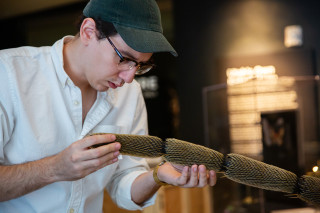
Fernando Jr. pieces together the antennae showing some of the thousands of setae. Photo by Mark Johnston
Other parts, like the insect's towering antennae, were particularly painstaking. Not only did they need to be lightweight and strong enough to be self-supporting, but to mimic the high-resolution scan of their specimen, they needed to be covered in thousands of hair like fibers called setae.
“The antenna had seven segments on each side and each one of these segments has roughly 1,000 setae, so that’s 14,000 setae of different sizes that were all cast, hand colored, and glued in one by one with tweezers!” Favila exclaimed.
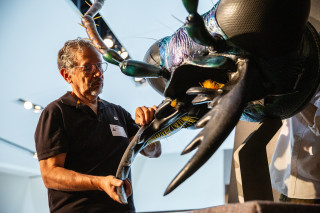
Fernando installs a mandible on the large tiger beetle sculpture during its installation at NHMU. Photo by Mark Johnston
To color the beetle head, Favila spent weeks photographing tiger beetle specimens to build two large binders of reference images. Those were delivered to the shop’s paint specialist, Mike Wowczuk, who replicated the colors perfectly with various layers of automotive paint resulting in rich blues and greens normally found only in the insect world.
From when the modeling commenced to when Wowczuk applied the last layer of paint, the process took a total of eight months with 10 craftsmen and support from a couple of outside vendors. When it was all said and done, Favila and the team sat back with excitement and relief to admire at the giant they created.
“The results just speak for themselves,” he said with a smile.
All their hard work is now on display at the Natural History Museum of Utah, where the tiger beetle head is making its premiere outside Levon Biss’s Microsculpture exhibition. Favila’s tiger beetle consultant, Gwiazdowski, was once a colleague of NHMU’s director, Dr. Jason Cryan, who was ecstatic to premiere the model and was on hand to watch its assembly.
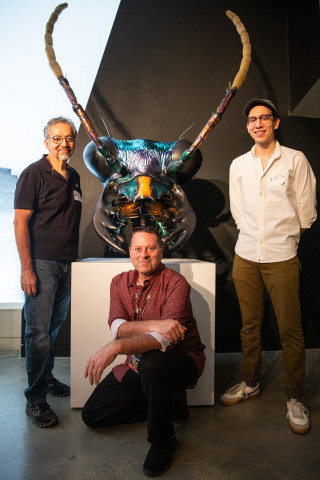
Dr. Jason Cryan, center, poses for a photograph with the two Fernandos after the installation of the tiger beetle head at NHMU. Photo by Mark Johnston
“The result is both fascinating and terrifying, as tiger beetles are known widely as consummate terrestrial predators. We’re thrilled to host the world premiere of this incredible sculpture,” said Cryan, whose scientific specialty is entomology.
After NHMU, Favila is booking appearances of the model at other museums and hopes enough interest will inspire a complete exhibition of similarly scaled and detailed invertebrates. It might even be something to rival the most spectacular fossil exhibitions like those at NHMU and NHMLA!
“Insects are the most numerous things on the planet, so you have a wealth of species to draw from and they’re so amazing that you could go on and on and on. They’re great to look at and learn about,” Favila said.
See the work of Favila and the Ironhead Studio team on display outside the Microsculpture exhibition, which is open at NHMU through September 15, 2024. Want more bugs? Check out BUGfest at NHMU on August 10–11, 2024.
